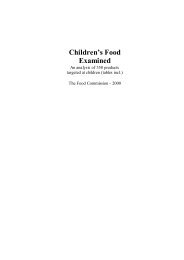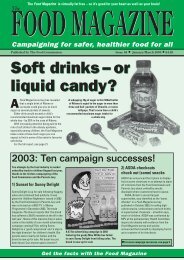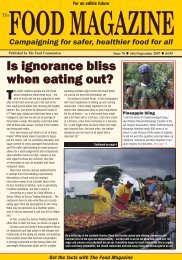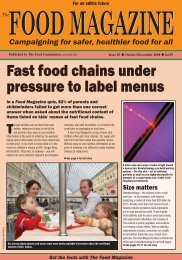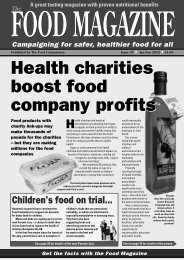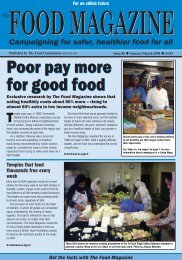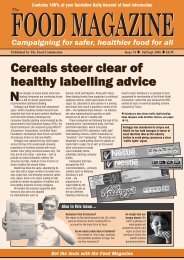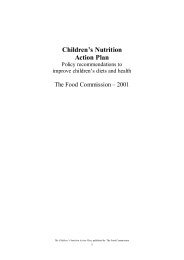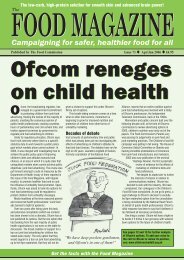Ignorance Is Not Bliss When Eating Out - The Food Commission
Ignorance Is Not Bliss When Eating Out - The Food Commission
Ignorance Is Not Bliss When Eating Out - The Food Commission
You also want an ePaper? Increase the reach of your titles
YUMPU automatically turns print PDFs into web optimized ePapers that Google loves.
<strong>Ignorance</strong> is not blisswhen eating out<strong>The</strong> need for nutrition labelling at fast foodand other chain restaurants<strong>The</strong> <strong>Food</strong> <strong>Commission</strong>December 2008www.foodmagazine.org.ukAnna Glayzer, CampaignerJessica Mitchell, Director1
AcknowledgementsThanks go to the Center for Science in the Public Interest and to the WoodcockFoundation for supporting us to produce this report. <strong>The</strong> <strong>Food</strong> <strong>Commission</strong> is acharity that campaigns for safer, healthier food for all and it would like to thank allindividuals who completed surveys to support us in this research. Thank youalso to Hannah Brinsden, the report’s researcher.2
ContentsPageAcknowledgementsSummary 41. Introduction: poor diets and ill health in the UK 62. British eating habits: too much salt, sugar and saturated fat 83. <strong>Eating</strong> out trends 84. Nutritional quality and impact of restaurant foods 84.1 Nutritional quality of popular restaurant foods 84.2 Portion sizes 114.3 Portion size and price 115. <strong>The</strong> <strong>Food</strong> <strong>Commission</strong> surveys 126. Nutrition information at restaurants 136.1 Nutrition information in the UK: the general context 136.2 Nutrition information at UK restaurants: present situation 146.3 Examples of better practice 146.3.1 Healthy Options Award, Wales6.3.2 Healthy Living Award, Scotland7. Consumer views on information provision when eating out 158. Menu labelling in the USA 159. Discussion and recommendations 1610. References 1811. Appendices 21Appendix A Sample survey 21Appendix B Companies with information on their websites 23Appendix C Examples of menu boards in the US 24Appendix D Letter sent to companies in Europe 25Appendix E <strong>Food</strong> Magazine article July/ September 2008 27Appendix F <strong>Food</strong> Magazine article July/September 2007 303
Summary• Obesity and overweight levels are soaring 24% of adults in England are obese. For men this figure has nearly doubledsince 1993. More than 55% of adults in Wales are overweight or obese. If no action is taken, by 2050, 60% of men and 50% of women, and 25% ofchildren will be obese. 58% of Type 2 diabetes, 21% of heart disease and between 8% and 42% ofcertain cancers (endometrial, breast, and colon) are attributable to excessbody fat. <strong>The</strong> cost of dealing with the many effects of obesity runs into billions ofpounds each year.• <strong>Food</strong> eaten out of the home is contributing to poor diet in the UK Menu items in popular UK chain restaurants are often high in calories,saturated fat, salt and sugar. <strong>The</strong> nutritional content of similar food items on the same menu can varywidely. Portion sizes are increasing, which means even higher calorie intakes.• More people are eating out Almost 30% of household expenditure on food is allocated to eating outsidethe home. 30 % of people eat out at least once a week.• 3 <strong>Food</strong> <strong>Commission</strong> surveys demonstrate that nutrition experts, andmembers of the general public are unable to guess the nutritional contentof fast food menu items Overwhelmingly, respondents cannot identify from their menu descriptionswhich items from fast food chain menus have the highest calorie, salt or fatcontents. Of the members of the general public questioned, more than 90% got 3 orfewer correct answers from 7 questions. Of parents and childminders quizzed about children’s menu items, 82%failed to get more than 1 correct answer in our 6 question survey. Of the experts, not one got all the answers correct.4
• Menu board labelling in food outlets would help consumers makehealthier choices <strong>The</strong> UK <strong>Food</strong> Standards Agency has been asked by the Government toassist consumers in making healthier choices when eating out and withhelping businesses improve the nutritional status of food offered but so farUK regulators are failing to insist companies provide prominent labelling ofnutritional information on menu boards. No food chains in the UK show nutritional information on their menu boards,menus or food tags. Some restaurants provide information on napkins and food packaging, or ontheir websites. Evidence shows that consumers do not find this as helpful. To help tackle obesity in the U.S., the state of California and local healthauthorities in Philadelphia, New York and Seattle have passed laws to forcefast food outlets to show calorie information on menu boards. Yum Brands! has agreed to post nutritional information on menu boards intheir restaurants in the USA (including Pizza Hut and KFC) but so far there isno sign of such action in the UK.• UK consumers have a right to informationWe propose that nutritional information, including calorie content, should beposted clearly at the point of sale as a mandatory requirement in UK food servicechains as part of Government strategies to save lives lost to diet-related disease.5
1. Introduction: Poor diets and ill health in the UKIn recent years, there has been an increase in the number of people classified asobese. Around one in four adults is now obese, with a body mass index (BMI) of30+. Between 1993 and 2005, the percentage of people classified as obese rosefrom approximately 13% to approximately 24% in men, and from more than 16%to greater than 24% amongst women (McPherson et al., 2007). According topredictions in Tackling obesities: Future choices – modelling future trends inobesity and their impact on health (McPherson et al., 2007), if no action is taken,by 2050, 60% of men and 50% of women, and 25% ofchildren will be obese.Obesity, a health risk in itself, is associated with manyother health problems such as diabetes, heart disease,some cancers and high blood pressure (McPherson et al,2007; Field, 2001). Associated illnesses are risingalongside obesity. For instance, between 1993 and2006, the prevalence of Type 2 diabetes in women inEngland more than doubled from 1.9% to 4.2%, (NHSInformation Centre, 2006 and NHS Information Centre,Obesity levels in the UKhave almost quadrupledsince the early 1980’s,when only 6% of menand 8% of women wereclassified as obese(British NutritionFoundation, 2005).2008). According to the Department of Health’s online information about obesity,(http://www.dh.gov.uk/en/Publichealth/Healthimprovement/Obesity/DH_078098),around 58% of type-2 diabetes, 21% of heart disease and between 8% and 42%of certain cancers (endometrial, breast, and colon) can be attributed to excessbody fat.As levels of obesity and dietary related diseases continue to rise, so do healthand economic costs, but these can be difficult to measure exactly. Costs, bothpersonal and societal, can accrue in a range of ways – due to treatment forphysical or mental ill-health, including for example, absenteeism at work. In2007, Tackling Obesities: Future Choices, predicted that, by 2050, obesityrelateddiseases could cost society an extra £45.5 billion per year (McPherson etal., 2007).In January 2008, the Government announced its ambition to become the, “firstmajor nation to reverse the rising tide of obesity and overweight in the populationby ensuring that everyone is able to achieve and maintain a healthy weight.”(Cross Government Obesity Unit, 2008, Healthy Weight Healthy Lives) Diet iscentral to this public health challenge. An estimated 70,000 premature deaths inthe UK could be avoided each year if diets matched nutritional guidelines interms of consumption of more fruit and vegetables and reduced consumption ofsalt, saturated fat and added sugar (<strong>The</strong> Cabinet Office, 2008).In July 2008, <strong>The</strong> Strategy unit of the Cabinet Office released, <strong>Food</strong> Matters:Towards a strategy for the 21 st century, which argued, “Given the evidence onthe impact of diet on British public health, a collective effort to speed up the UK’s6
transition to a healthier diet has to be a key focus for policy in the years ahead.”Part of the strategy should include, according to the report, supporting theconsumer to make healthier food choices when eating both in and out of thehome (<strong>The</strong> Cabinet Office, 2008). Consequently, the <strong>Food</strong> Standards Agency(FSA) has been charged with expanding its work programme with foodbusinesses and consumers to understand what nutritional information consumerswould find helpful when eating out; and to help food businesses to improve thenutritional quality of the food served. This has led to chain restaurants, includingBurger King, McDonalds, KFC and Subway, committing to taking steps to offermore healthy options and to provide nutritional information to consumers,however none of these chains will offer information on menus (<strong>Food</strong> StandardsAgency, 2008, High street restaurants sign up to healthy eating)<strong>The</strong>re have recently been moves in the USA to force better disclosure of nutritioninformation at so-called chain restaurants. California recently became the firststate to legally require calorie counts on chain restaurant menus and menuboards (CSPI Newsroom, September 2008). <strong>The</strong> local health authorities for NewYork City and Seattle have also enacted legislation requiring nutrition informationto be available at the point of sale on the menu boards in food service chainswith a number of outlets that offer standard menus. Exemptions are made forsmall firms with few outlets, and for companies that have non-standard menus.This report looks at how the provision of similar information in the UK would helpconsumers make healthier choices and recommends that the FSA requiremandatory nutritional disclosure at point of sale, in a range of formats.7
2. British eating habits: too much salt, sugar and saturated fatAn average British adult consumes too much salt, sugar and saturated fat, andtoo little wholegrain, oily fish and fruit and vegetables (NHS Information Centre,2008; National Statistics 2003). Despite the UK’s daily salt intake falling from 9.5to 8.6 grams (g) (<strong>Food</strong> Standards Agency, 2008, Salt Levels Continue to Fall),the reduction falls a long way short of the recommended 6g a day maximumintake for adults. Sugars, other than those from milk and fruits, should only makeup a maximum of 10% of daily energy intake (British Nutrition Foundation, 2005).Yet, according to the National Diet and Nutrition Survey (National Statistics,2003), in adults surveyed, sugar made up an average of 13.4% of men’s energyintake and 11.9% of women’s. <strong>The</strong> average in some age groups was evenhigher. <strong>The</strong>re is some evidence that for certain individuals from low incomegroups, almost 50% of dietary energy intake could be down to sugar (Nelson etal. 2007, Low income diet and nutrition survey). Current population averageintakes of saturated fat also exceed public health recommendations and it hasbeen estimated that a reduction in average saturated fat intakes from the currentlevel of 13.3% to the recommended 11% of food energy would equate toapproximately 3,500 annual UK deaths averted (<strong>Food</strong> Standards Agency, 2007,Draft Saturated Fat and Energy Intake Programme).3. <strong>Eating</strong> out trends<strong>Eating</strong> out has become a major part of everyday life inthe UK. Almost 30% of household expenditure on food isnow allocated to eating outside the home (Cabinet Office,2008). Exact figures are hard to obtain, but a report bythe Institute of Grocery Distribution recorded that onaverage, 30% of people surveyed eat out at least once aweek. This figure has doubled since 2003, when theaverage was 13%. Within the 18-24 age group theRestaurants, cafes,and other food outletsprovide one in every 6meals and capture27% of money spenton food (NationalStatistics Family <strong>Food</strong>Survey, 2005-2006).average number of people who eat out at least once a week is even higher, at61% (IGD, 2007).4. Nutritional quality and impact of restaurant foodsWith the increased frequency with which people eat outside the home, there isnow more reason than ever to consider the nutritional quality of the foodsavailable. Restaurant foods are often high in calories, saturated fat, sugar andsalt; served in large portions; and priced in a way that makes large serving sizesmore appealing (Appendix F).4.1 Nutritional quality of popular restaurant foods8
A recent Which? report (Pilau Talk, 2008) surveyed calorie, sugar, fat, saturatedfat and salt content of Indian, Chinese and Pizza takeaways and found that asingle Indian takeaway could contain 23.2g of saturated fat, higher than therecommended 20g maximum daily allowance for women. <strong>The</strong> survey also foundthat some Indian and Chinese takeaway meals were so high in calories, theywould contribute nearly ¾ of an adult woman’s daily estimated averagerequirement of calories (approximately 1950). <strong>The</strong> <strong>Food</strong> Magazine regularlyreports on surveys of nutritional content of meals eaten out undertaken by tradingstandards departments around the UK (Appendix F). <strong>The</strong>se surveys areaccessible online through trading standards departments and often show veryhigh levels of saturated fat, salt, calories and sugar.9
Box 1: Nutritional quality of foods varies widely, even between products which appearsimilarMcDonald’s Chicken Products Calories Total Fat Saturated fat SaltChicken McNuggets(tm) (6 pieces) 250 14.0 2.0 0.6McChicken(tm) Sandwich 380 16.0 2.0 1.6Chicken Legend(tm) with Spicy Tomato Salsa 515 14.0 2.0 2.6Chicken Selects(tm) (5 pieces) 610 33.0 4.0 2.8Toasted Deli Sweet Chilli Chicken with Cheese 665 20.0 5.0 2.7(White Roll)<strong>When</strong> in McDonald’s, there is a wide range of chicken products available with varying calorie and saturated fatcontent. A McChicken Sandwich contains 380 calories and 2g of saturated fat, whereas a Toasted Deli SweetChilli Chicken with Cheese has 665 calories and 6g of saturated fat. Nearly double the calories and three times thesaturated fat in one chicken burger compared to another.Pret A Manger Cakes and Slices Calories Total Fat Saturated fat SodiumChocolate Brownie 267 15.7 9.8 0.0386Chocolate Card Box Cake 354 20.09 6.6 0.241Choc Bar 555 38.6 22.7 0.611Each of these might be chosen as a coffee accompaniment, and in a display could look very similar. <strong>The</strong>nutritional values vary highly however, with the Choc Bar having more than double the amount of fat, saturated fatand calories of a chocolate brownie.Desserts at a popular pub chain-Calories Total Fat Saturated fatWetherspoonsMango & Passion fruit Sorbet 115 0.1 0Mint Chocolate Ice-cream Bomb 300 13.4 8.4Warm Chocolate Brownie with vanilla Ice-cream 334 17.5 10.8Bramley apple, pear and raspberry crumble with 579 24.4 11.6ice creamBramley apple, pear and raspberry crumble withcustard642 23.6 11.5Although the sorbet might be assumed to be the healthiest product, the other items might surprise restaurantgoers. For instance, there is an added 63 calories when custard is the crumble accompaniment rather than icecream, and an added 245 calories when crumble is chosen over the chocolate brownie. Information collected inspring 2008. Products are regularly reformulated so the nutritional content of items will change.Restaurant appetizers and side dishes can account for a surprisingly largeproportion of recommended daily calorie intake, and high contributions ofsaturated fat, even before a main meal is consumed. For example, at pub chainWetherspoons, a side order of half a rack of BBQ pork loin ribs is 819 calories,whilst a meal of chips with chili con carne contains 931 calories. Beer batteredonion rings provide 7.3g saturated fat and garlic ciabatta bread would provide10.4g saturated fat. <strong>The</strong> nutritional quality of different items on the same menucan vary widely, and unexpectedly. For example at Wimpy, a jacket potato andcheese has 1012 calories, 51.3g fat and 33.6g saturates compared to a classicbacon cheeseburger with large chips which contains 745 calories, 37g fat, 11.5gsaturates. Even products which appear similar on a menu can have verydifferent calorie and fat content. See Box 1 for examples.10
4.2 Portion Sizes.Larger portion sizes can contribute to higher calorie, saturated fat, sugar and saltintake when eating out. Some items on fast food menus have increased in sizesince the early 1990s, such as the McDonald’s Big Mac (204g in 1993;approximately 216g now) and McChicken Sandwich (159g in1993; approximately170g in 2008) and the Burger King Whopper (258g in 1993 to 274g in 2008) anda double Whopper with cheese (359g in 1993 to 380g in 2008) (Church, 2008).In some instances, snacks bought out of the home are much bigger than shopbought alternatives, for example Starbucks cookies which weigh around 120g,compared to Maryland Chocolate Chip Cookies, which have not increased inweight (about 10-12g) since 1993 (Church, 2008).4.3 Portion Size and PriceAlongside portion sizes increasing, many food outlets offer size upgrades at asmall price difference. At Burger King, for instance, it costs just 40 pencedifference to buy super size fries instead of regular. <strong>The</strong> extra 40 pence buys anextra 167 calories and an extra 3g of saturated fat. See box 2 for this and furtherexamples of how different size servings of the same item can vary in calorie, fat,and saturated fat content.Box 2 – Portion sizes and PriceStarbucks Drinks – Mocha Frappuccino with Whipped CreamSize calories Total fat Saturated PriceFatTall 283 10.8 6.5 £3.25Grande 378 14.8 8.8 £3.45Venti 428 14.9 9.0 £3.65Burger King FriesSize calories Total fat Saturated PriceFatRegular 294 14 5 £1.34large 363 17 6 £1.54Super 461 22 8 £1.74McDonald’s Coca-colaSize calories Sugar PriceSmall 105 26 89pMedium 170 42 99pLarge 210 53 £1.29By upgrading the Frappuccino from a Tall to a Venti for just 40 pence, a woman would beconsuming almost ¼ of her estimated average requirement for calories and half therecommended maximum intake of saturated fat in just one drink. At Burger King, “supersizing”fries would mean a woman consuming almost half of the recommended daily maximum intake ofsaturated fat. At McDonald’s, upgrading from a small to a large coca-cola means doubling thenumber of calories ingested for just 40 pence. Information collected spring 2008. Productsare regularly reformulated so the nutritional content of items will change.11
5. <strong>The</strong> <strong>Food</strong> <strong>Commission</strong> surveysBetween May and October 2008, <strong>The</strong> <strong>Food</strong> <strong>Commission</strong> conducted threesurveys to establish whether nutrition and obesity experts, members of thepublic; and parents / childminders could correctly identify which items from fastfood menus contained the highest levels of fat and calories. See Appendix D forthe full <strong>Food</strong> Magazine article on the findings from the first two surveys.<strong>The</strong> first survey was conducted in Geneva, at the European Congress on Obesity2008. 66 nutrition and obesity specialists were asked multiple choice questionsabout the fat and calorie content of different fast food products, based on themenu descriptions. Of the five questions asked, not one respondent got all theanswers correct, with the vast majority getting just one or two correct.A larger survey, with seven similar questions, was conducted with 220 membersof the general public in two street locations in London. Only one person guessedall the answers correctly, while 91% got three or fewer of the answers correct.11.8% got none of the answers correct. For full details of the questions asked,and the answers to the public survey, see Appendix A. Of parents andchildminders quizzed about children’s menu items in Autumn 2008, 82% failed toget more than 1 correct answer in our 6 question survey (see <strong>Food</strong> Magazineissue 83 for details).Questions answered in the public survey included the following (the percentagesrepresent the proportion of people who selected each answer):Which sub from Subway has the most calories?A tuna salad) = 5.4%B steak and cheese = 39.1%C Subway melt = 50.9%D veggie patty= 4.5% correct answerFor one question about subsfrom Subway, only 10 peopleguessed the correct answer –that a 6 inch veggie pattycontained the most calories. At414 calories this was in fact 63calories more than the most popular choice, the Subway melt, and 78 caloriesmore than the second favourite guess, the steak and cheese sub.For another question about fat content ofKFC menu items, only 48 people guessedwhich had the most fat, the coleslaw,which contained 22.4g. Most respondentsguessed Popcorn Chicken, which actuallycontained 17.8g of fat.Which item at KFC has the most fat?A large coleslaw = 21.8% correct answerB regular popcorn chicken = 31.4%C large fries = 30.5%D fillet burger = 16.4%Which meal item at Burger King has the mostamountof total fat?A double Whopper with cheese = 25.5% correctanswerB bacon double cheese burger = 5.9%C XL bacon double cheeseburger = 50%D smoked bacon and cheddar angus = 18.6%For a question on Burger King menuitems, half of the respondents guessedthat the XL bacon double cheeseburger12
had the most amount of total fat. Only 25% respondents identified the correctanswer, the double whopper with cheese, which at 57g, contained 6 g more fatthan the XL bacon double cheeseburger.6. Nutrition information at restaurants6.1 Nutrition information in the UK: the general contextRestaurants, fast food outlets and other takeaway establishments are currentlyexcluded from any requirement to provide nutrition information at the point ofsale. Voluntary schemes are in place in some areas, but formats vary, as dolevels and type of outside assessment. <strong>The</strong> <strong>Food</strong> <strong>Commission</strong> met with the<strong>Food</strong> Standards Agency in July 2008. <strong>The</strong> agency is currently conductingconsumer research to determine what type of information would be most helpful,and is in discussion with fast food companies. This has led to chain restaurants,including Burger King, McDonalds, KFC and Subway, committing to taking stepsto offer more healthy options and to provide nutritional information to consumers,however none of these chains will offer prominent information on menu boards(<strong>Food</strong> Standards Agency, 2008, High street restaurants sign up to healthyeating). <strong>The</strong> most that restaurants promise is to review the content and format ofinformation available.<strong>The</strong>re has been little open discussion as to exactly what format menu nutritionalinformation should take; but it is clear that calorie information will not offersupport to consumers in avoiding other nutrients that are also the subject ofpublic health campaigns. However, calories are a good marker for sugar and fatcontent of foods, and calorie information is easy to post on menu boards, at littlecost to restaurants. Some high calorie products are low in salt – so, saltinformation could be a useful addition to prominent calorie labelling.<strong>The</strong> <strong>Food</strong> <strong>Commission</strong> has written to 14 Head Offices of companies in the UKand Europe. No company has advised us of any plans to provide prominent,nutritional information at the point of sale. This includes Yum Brands! – whichwill offer calorie information at member restaurants in the USA, but not in the UK.Meanwhile, the Cabinet Office’s <strong>Food</strong> Matters report (Section 1) argues that theUK has led the world in the development of front-of-pack nutritional labelling forfoods bought for preparation and consumption at home, and that front of packlabelling has driven reformulation to make products more healthy (Cabinet Office,2008).<strong>The</strong>re is no single system in place for front of pack labelling in the UK. <strong>The</strong>system advocated by the <strong>Food</strong> Standards Agency is the “Traffic Light Labelling”system (<strong>Food</strong> Standards Agency, 2007, Traffic light labelling). <strong>The</strong> labelsrepresent fat, saturates, salt and sugars, and are presented in red, amber orgreen depending on whether the product contains high (red), medium (amber) or13
low (green) levels of each nutrient. <strong>The</strong> traffic light scheme has been found tomost influence consumer choice (Cabinet Office, 2008). <strong>The</strong> scheme has beenadopted by retailers and companies including Marks & Spencer, Waitrose,McCain, Boots and Bernard Matthews. Other companies such as Tesco andNestlé have chosen not to follow the FSA’s preferred system, opting instead todisplay the fat, saturate, sugar and salt content present in the product as apercentage of guideline daily amounts (GDA) on the front of pack (<strong>Food</strong>Standards Agency, 2007, Traffic light labelling). <strong>The</strong> <strong>Food</strong> <strong>Commission</strong> backsmandatory traffic light labelling.6.2 Nutrition information at UK restaurants: present situationNo UK restaurant visited during the preparation of this report, provided nutritioninformation on menu boards, food tags or menus. Some companies do make thisinformation available in restaurants either on food packaging, trays and napkinsfor perusal whilst eating or on leaflets available by specific request. <strong>The</strong> NationalConsumer Council looked at the availability of nutrition information in 7 majorchain takeaways in the UK (Allder, 2008, Takeaway health). Nutrition informationwas frequently found to be either not available, or only available on leaflets, or ontray liners. Informal research conducted as part of this report, whilst gatheringinformation for consumer surveys (Section 5) confirms these findings. Somecompanies provide nutrition information on their websites. For a list ofrestaurants that provide information online see Appendix B.6.3 Examples of better practice6.3.1 Healthy Options Award, WalesIn Wales, a voluntary scheme called the Healthy Options Award has beendeveloped by local councils and the FSA. <strong>The</strong> aim is to recognise and encouragecatering premises to provide healthy options to the public by awarding bronze,silver, gold status according to menu composition. <strong>The</strong> award schemerecognises the provision of meals which are balanced and include fruit,vegetables, complex carbohydrates, and which have decreased amounts of fat,saturated fat, salt and sugar. <strong>The</strong> scheme also recognises provision of healthyoptions for children, and rewards staff training and promotion and marketing ofthese healthier options. Guidance and suggestions of change are madeavailable to restaurants.6.3.2 Healthy Living Award, ScotlandAnother voluntary scheme, the Healthy Living Award, was launched in 2006, andis run by the Scottish Consumer Council and funded by the Scottish Executive.<strong>The</strong> award promotes healthier eating and is open to all kinds of catering places,from sandwich shops to staff restaurants. By July 2008, 870 companies hadapplied for the award, and over 320 had achieved healthy living status, earning14
the right to display the healthy living green apple logo on menus (Cabinet Office2008).As with the Welsh scheme, assessors look at the nutritional balance of mealsprovided, including whether levels of fat, sugar and salt are acceptable.Companies should provide healthy and nutritious children’s food whereappropriate, and at least 50 per cent of the food on the menu must be labelled as“healthy living” choices. Companies must also have a sales promotion andmarketing strategy which works alongside the general principles of the healthyliving award and supports healthier eating.7. Consumer views on information provision when eating outIn 2008, the <strong>Food</strong> Standards Agency surveyed more than 2,000 people acrossthe UK to try and find out what consumers want when they eat out (<strong>Food</strong>Standards Agency, 2008, Consumers views on eating out.). <strong>The</strong> findings showedthat overall 42% bought a meal out at least once a week. 85% of peoplesurveyed agreed that restaurants, pubs and cafes have a responsibility to make itclear what is in the food they serve. 81% of people said they felt nutritionalinformation shown at the point when they order food, such as on a menuwould be useful. Although many companies have nutrition booklets on theircompany websites, only 2% indicated that they find this useful.<strong>When</strong> the National Consumer Council has looked at the availability of nutritioninformation in 7 major chain takeaways in the UK, it also surveyed the views of1000 consumers (Allder, 2008, Takeaway health). 72% of the 1000 peoplesurveyed, said nutritional information on boards would be helpful.8. Menu labelling in the USACalifornia has recently signed legislation making calorie counts on chainrestaurant menus and menu boards mandatory. <strong>The</strong> local health authorities forNew York City and Seattle have also enacted legislation requiring nutritioninformation to be available at the point of sale (CSPI Newsroom, September2008). Restaurants and fast food chains in LA may soon follow suit (Reuters,2008). In Seattle, chain restaurants with more than 10 national outlets and$1million in annual sales must have menus showing calories, saturated fat, transfat, sodium and carbohydrate. In New York City chain restaurants with 15 ormore national outlets must list the calorie content of standard items on menu,menu boards or display tags and information should be at least as prominent asthe price. Exemptions are made for small firms with few outlets, and forcompanies that have non-standard menus. See Appendix C for examples ofmenu boards from the USA.According to the Deputy <strong>Commission</strong>er in the public health department in NewYork, Dr. Lynn Silver, prominent, point of sale information on menu boards is15
crucial if effects are to be seen with regard to improvements in people’s foodchoices. Early evaluation work in New York city is showing evidence of productreformulation (to reduce calories), and of consumers using available informationto make lower calorie choices (Personal Communication, 2008).Yum! Brands announced in autumn 2008 that it would offer nutritional disclosuresat point of sale in its restaurants in the USA. This will include KFC and PizzaHut, both large chains in the UK. <strong>The</strong> <strong>Food</strong> <strong>Commission</strong> has called for thecompany to do the same here, but no such commitment has yet been made.Picture 1: Subway menu board in the US showing calorie values next toprice9. Discussion and recommendationsIn the UK, eating out is a popular pastime with almost 30% of householdexpenditure now allocated to eating outside the home. It is clear that mealseaten out are often very high in terms of calories, saturated fat, salt and sugar.Evidence about these high levels has been presented in this report, and in thereports of other campaign groups referred to in this report (Which?; <strong>The</strong> NationalConsumer Council) and from trading standards departments (see Appendix F).It is also clear that obesity is already causing significant suffering for individualsand pain for the UK economy.However, consumers are still denied nutritional information on menu boards atpoint of sale in UK restaurants. This report has uncovered no examples of anyUK restaurant providing nutrition information at the point of sale. Companiescontinue to assert that nutritional information is available in other formats, forexample: on company websites; on placemats offered with meals served; fromstaff or on leaflets.16
Surveys conducted for this report indicate that neither experts nor consumers areable to guess which menu items at fast food chains are lowest in calories, or fatand sugar. In <strong>Food</strong> Standards Agency and National Consumer Council surveys(<strong>Food</strong> Standards Agency, 2008, Consumers views on eating out; Allder, 2008),consumers indicated overwhelmingly that they would welcome nutritioninformation at the point of sale. In the FSA survey, only 2% of people said thatthey found the provision of nutrition information on company websites useful.In the U.S.A, action to address the lack of calorie information in restaurants isbacked by the <strong>Food</strong> and Drug Administration’s Obesity Working Group, <strong>The</strong>American Medical Association, the American Public Health Association, <strong>The</strong>American Cancer Society and the American Diabetes Association (Friedman,2008). California recently passed legislation requiring calorie counts on chainrestaurant menus and menu boards (CSPI Newsroom, September 2008). <strong>The</strong>local health authorities for New York City and Seattle have also enactedlegislation.In the UK, the FSA is currently engaged in work to consider possible formats forthe provision of point of sale nutrition information, and recommendations forrolling out such activity to restaurants. However, although the Agency’s mostrecent release on the subject High street restaurants sign up to healthy eating(FSA, 2008) claims success in the form of chain restaurants, including BurgerKing, McDonalds, KFC and Subway, committing to taking steps to offer morehealthy options and to provide nutritional information to consumers, none ofthese chains will offer prominent information on menu boards.This report is intended as a campaigning tool, and it is also hoped that it willsupport the FSA in developing its ideas. Recommendations are made in the lightof:• Rising rates of obesity, and other diet-related chronic health conditions in theUK• An increase in the frequency of meals eaten out• Data that shows high levels of calories, saturated fat, salt and sugar in mealseaten out• Evidence that consumers are unable to guess which menu items are lower incalories, saturated fat, sugar and salt• Evidence that consumers welcome prominent information at the point of sale,and that very few people find the provision of information on company websitesuseful17
• Evidence from New York that shows calorie labelling has led to productreformulation and to consumers making lower calorie food choicesList of recommendations• <strong>The</strong> FSA should call for the mandatory provision of calorie information, permeal item, on menu boards of so-called food service chains. <strong>The</strong> calorieinformation should be in text as large as the item price. <strong>The</strong> FSA shoulddetermine a UK definition of a food-service chain, with a focus on the number ofoutlets for such restaurants.• <strong>The</strong> FSA should explore methods for such food service chain menu boards tooffer standard portion (100 grams) information about salt.• <strong>The</strong> FSA should run a public health campaign to educate people about calories.18
10. References1. Allder J. (2008) Takeaway Health: how takeaway restaurants can affect yourchances of a healthy diet. National Consumer Council.2. British Nutrition Foundation (2005)http://www.nutrition.org.uk/home.asp?siteId=43§ionId=429&subSectionId=322&parentSection=299&which=1#1007 [accessed 7/8/2008]3. Burger King: http://www.burgerking.co.uk/nutrition/index.aspx [accessed1/8/2008]4. Cabinet Office (2008) <strong>Food</strong> Matters. Towards a strategy for the 21 st Century.Cabinet Office.5. Center for Science in the Public Interest (2008) Anyone’s guess: <strong>The</strong> need fornutrition labelling at Fast-<strong>Food</strong> and other chain restaurants. Center forScience in the Public Interest, USA.Center for Science in the Public InterestNewsroom (2008) http://www.cspinet.org/new/ Center for Science in thePublic Interest, USA.6. Church S. (2008) Trends in portion sizes in the UK – A preliminary review ofpublished information. <strong>Food</strong> Standards Agency7. Department of Health (2008), Obesity general information,http://www.dh.gov.uk/en/Publichealth/Healthimprovement/Obesity/DH_078098 [accessed 1/9/2008]8. Cross Government Obesity Unit (2008) Healthy Weight Healthy Lives: ACross Governmental Strategy for England. Department of Health &Department for Children, Schools and Families.9. Field AE, Coakley EK, Must A, Spadano JL, Laird N, Dietz WH, et al. (2001)Impact of overweight on the risk of developing common chronic diseasesduring a 10 year period. Arch Intern Med; 161: 1581-1586.10. <strong>Food</strong> Standards Agency (2007) Draft Saturated Fat and Energy IntakeProgramme:http://www.fsascience.net/sites/fsascience.net/files/fatenergyprog.pdf. [accessed 27/8/2008]11. <strong>Food</strong> Standards Agency (2008) Traffic light labellinghttp://www.eatwell.gov.uk/foodlabels/trafficlights/ [accessed 1/8/2008]12. <strong>Food</strong> Standards Agency (22 nd July 2008) Salt levels continue to fall.http://www.food.gov.uk/news/newsarchive/2008/jul/sodiumrep08 [accessed31/7/ 2008].13. <strong>Food</strong> Standards Agency (30 th July 2008) More catering companies commit tohealthier foods http://www.food.gov.uk/news/newsarchive/2008/jul/catcom2[accessed 31st July 2008]14. <strong>Food</strong> Standards Agency (2008) Consumer views on eating out. CAPIOmnibus.15. <strong>Food</strong> Standards Agency (20 th November 2008) High street restaurants signup to healthy eating19
http://www.food.gov.uk/news/newsarchive/2008/nov/hccnov08 [accessed20/11/2008]16. Friedman, R. (2008) Menu labelling: Opportunities for public policy. YaleRudd Center for <strong>Food</strong> Policy and Obesity17. Genehan AG, Tyson M, Egger M, et al. (2008) BMI and incidence of cancer: asystematic review and meta-analysis of prospective observational studies,<strong>The</strong> Lancet, 371:569-578.18. Healthy Living Award http://www.healthylivingaward.co.uk/index.asp[accessed 31/7/2008]19. Institute for Grocery Distribution (2007) <strong>Eating</strong> <strong>Out</strong>. IGD20. McDonalds:http://www.mcdonalds.co.uk/asp/ourfood/asp/nutritioncounter.asp [accessed9/10/2008]21. McPherson K et al.(2007) Foresight report - Tackling Obesities: FutureChoices - modelling future trends in obesity and their impact on health .Government Office for Science.22. National Statistics (2003) National Diet & Nutrition Survey: adults aged 19-64years, volume 2. National Statistics.23. NHS Information Centre (2006) Health Survey for England 2005 latestTrends. NHS information Centre.24. NHS Information Centre (2008) Health Survey for England 2006 LatestTrends. NHS Information Centre25. Pret a Manger: http://www.pret.com/menu/bakery/ [accessed 9/10/2008]26. Reuters (2008) L.A. may force restaurants to post calories on menushttp://uk.reuters.com/article/marketsNewsUS/idUKN0738339220080808?rpc=401&&pageNumber=2. Reuters. [accessed 8 th August 2008]27. Sidall R. (2008) Higher body mass index means higher risk of severalcancers. National Obesity Forum28. Starbucks: http://www.starbucks.co.uk/en-GB/_Favorite+Beverages/Beverage+Nutrition.htm [accessed 1/8/2008]29. Wetherspoons:http://www.rfbrookes.co.uk/Web/<strong>Food</strong>Facts/<strong>Food</strong>Facts.nsf/PopUpForm?OpenFrameSet [accessed 9/10/08]30. Which? (2008) Pilau Talk.31. Wimpy:http://www.wimpy.uk.com/downloads/Nutri/Nutri%20Anlss%202006.pdf[accessed 31/1/08]20
11. AppendicesAppendix A: <strong>The</strong> <strong>Food</strong> <strong>Commission</strong> public survey, answers shown in red(note this information was correct in late spring 2008)UK Restaurant Quiz1. Which item from McDonalds has the most calories:a) 1 Large Strawberry Shake (505 cal)b) 1 Big Mac (495 cal)c) 9 piece Chicken McNuggets (390 cal)d) Large French Fries (455 cal)2. How many grams of fat are in a McDonald’s Sausage, Egg and Cheese Bagel?a) 16b) 20c) 24d) 283. Which sub at Subway has the most calories: (note: subs are on whole wheatbread with lettuce, tomato, pickles, onions, green peppers, olives and cheese)a) 6 inch Tuna Salad Sub (402 cal)b) 6 inch Steak and Cheese Sub (336 cal)c) 6 inch Subway Melt (Turkey, Ham, Bacon and Cheese) (351 cal)d) 6 inch Veggie Patty Sub (414 cal)4. Which Grande (500 ml) drink at Starbucks has the most calories:a) Coffee Frappucino (239 cal)b) White Chocolate mocha with semi skimmed milk, no whipped cream (399cal)c) Cappuccino with semi skimmed milk (115 cal)d) Café Latte with semi skimmed milk (188 cal)5. Which meal item at Burger King has the most amount of fat?a) Double Whopper with Cheese (57 grams)b) Bacon Double Cheeseburger (27 grams)21
c) XL Bacon Double Cheeseburger (51 grams)d) Smoked Bacon and Cheddar Angus (41 grams)6. How many calories are in a 6 inch individual pan pizza from Pizza Hut?a) 508b) 608c) 708d) 8087. Which item at Kentucky Fried Chicken has the most amount of fat?a) Large Coleslaw (22.4 grams)b) Regular Popcorn Chicken (17.8 grams)c) Large Fries (19.4 grams)d) Fillet Burger (15.6 grams)22
Appendix B - Examples of companies that provide nutritional informationon their websitesAMT coffee: http://www.amtcoffee.co.uk/Burger King: http://www.burgerking.co.uk/nutrition/index.aspxCafé Nero: http://www.caffenero.com/Nero<strong>Food</strong>.asp?Section=NutritionalInfoCafé Rouge: http://www.caferouge.co.uk/corp_nutrition.phpChilli’s Grill & Bar: http://www.brinker.com/gr/nutritional/chilis_nutrition_menu.pdfCosta Coffee: http://www.costa.co.uk/coffee/ourfood.aspxDominoes: http://www.dominos.co.uk/about/nutrition.aspxHarvester: http://www.harvester.co.uk/nutritional-information.htmlKFC: http://www.kfc.co.uk/nutrition/nutrition.aspxKrispy Kreme: http://www.krispykreme.co.uk/Nutritional-infoMcDonalds: http://www.mcdonalds.co.uk/asp/ourfood/asp/nutritioncounter.aspMillies Cookies:http://www.milliescookies.com/uploads/doc/605_nutritional_info_cookies.pdfPizza Hut: http://www.pizzahut.co.uk/restaurant/nutritional-information.htmlPret a Manger: http://www.pret.com/menu/sandwiches/Starbucks: http://www.starbucks.co.uk/en-GB/_Favorite+Beverages/Beverage+Nutrition.htmSubway: http://www.subway.co.uk/menu_nutrition_info.aspWetherspoons:http://www.rfbrookes.co.uk/Web/<strong>Food</strong>Facts/<strong>Food</strong>Facts.nsf/PopUpForm?OpenFrameSetWimpy: http://www.wimpy.uk.com/nutrition.htmYO! Sushi: http://www.yosushi.com/files/fb506c17-/YO!NutritionalBooklet.pdf23
Appendix C – Examples of menu boards in the USExample of envisaged McDonalds Menu Boardhttp://www.cspinet.org/menulabeling/images/ml_mcdonalds.gifExample Starbucks Menu Boardhttp://www.cspinet.org/menulabeling/images/starbuckssandwiches.jpgExample labelling of fresh food at Starbuckshttp://www.cspinet.org/menulabeling/images/starbucksfoodtag.jpgExample Subway menu boardhttp://www.cspinet.org/menulabeling/images/subwaydoublestacked.jpg24
Appendix D Example of letter written to fast food companies in the UKNameAddressDate: 30 th July 2008Dear ............,We are writing to request that your company disclose nutrition information onmenu boards and menus immediately adjacent to the name and price of eachstandardised item. Such requirements are in place in several American cities,and we understand that your company is complying, or about to comply, withsuch requirements in San Francisco and New York. Health conscious consumershere would also benefit from such information.Obesity and diet-related diseases have increased significantly as more and moreconsumers are eating outside of the home. In a major study of 36,894individuals from ten European countries, researchers found that this shift indietary habits is directly correlated to increased energy intake and obesity. 1Studies by the City of Los Angeles and New York City health departmentsdemonstrate that such disclosures help consumers choose healthier options andimprove their health. <strong>The</strong>se studies also indicate that disclosures in places suchas posters, brochures, tray liners, packages, and www sites do not have a similarimpact. 2 See Attachment 1 – Transatlantic Consumer Dialogue Resolution forcomplete discussion.1 P. Orfanos et al. <strong>Eating</strong> <strong>Out</strong> of Home and Its Correlates in 10 European Countries. <strong>The</strong> EuropeanProspective Inbestigation into Cancer and Nutrition (EPIC) Study. Public Health Nutrition: 10(12), 1515-1525. 21 June 2007.2 Bassett, Mary et al. Purchasing Behavior and Calorie Information at Fast-<strong>Food</strong> Chains in New York City,2007, American Journal of Public Health, June, 2008; Simon, Paul et al. “Menu Labeling as a PotentialStrategy for Combating the Obesity Epidemic: A Health Impact Assessment,” May 2008, County of LosAngeles, Public Health Division of Chronic Disease and Injury Prevention.25
Consumers strongly favour disclosure of nutrition information for standardisedrestaurant foods. According to the results of an Opinion Research Corporationsurvey commissioned by the Transatlantic Consumer Dialogue, more than 75%of consumers “agree” or “strongly agree” that “fast food restaurants and otherchains should list nutritional information, such as calories, fat, sugar or saltcontent on menus and menu boards.”We believe that requiring nutrition disclosures on menus and menu boards willcontribute to the European Platform on Diet, Physical Activity and Health andgarner considerable goodwill amongst consumers.We thank you for your consideration of this request, and we look forward to yourresponse.Yours sincerely,Anna GlayzerCampaign Coordinator<strong>The</strong> <strong>Food</strong> <strong>Commission</strong>anna@foodcomm.org.ukCC:Jessica MitchellDirector<strong>Food</strong> <strong>Commission</strong>26
Appendix E: <strong>Food</strong> Magazine Article July/ September 2008Which fast food meals are healthiest? Anyone’s guess!<strong>When</strong> <strong>The</strong> <strong>Food</strong> Magazine asked nutrition specialists and members of the publicwhich fast foods were most laden with fats or calories. <strong>The</strong> results weresurprisingly poor.<strong>The</strong> lack of clear labelling for fast food meals means that few people really knowwhat they are ordering. We believe it is time to follow the example of cities suchas New York and Seattle, and get the fatty facts publicly declared on menuboards.We are eating out of the home more than ever before, but the food we eat israrely labelled with nutrition details. In the supermarket, we can look at the labelsand make a decision, but in McDonalds, Starbucks, Pizza Hut, KFC or Subway,the display boards show no nutritional information at all. We may find some factsavailable in leaflets, or on the containers or tray liners, but that information comesafter we have made our choice, collected our meal and sat down to eat. All wecan do then is say, “I wish I had known before I ordered.”Surveys show that meals eaten outside the home are frequently higher incalories and fats than food prepared and cooked at home. This means thatcaterers have as much responsibility as supermarkets to ensure we get the factsbefore we choose.<strong>The</strong>re are already moves in the USA to force better disclosure. <strong>The</strong> local healthauthorities for New York City and Seattle have enacted legislation requiringnutrition information to be available at the point of sale. Exemptions are made forsmall firms with few outlets, and for companies that have non-standard menus.<strong>The</strong> fast food outlets are fighting back with legal challenges, but the signs aregood that the laws will stick and customers will get the information they surelydeserve to have. After all, what are companies trying to hide!In Europe, no such laws are yet envisaged. <strong>The</strong> <strong>Food</strong> Standards Agency ispromising to look into the issue in the next year or so, but we believe it is time topress forward now. <strong>The</strong> logic is clear: customers have a right to know what theyare being sold. This is especially true for products that rely for their appeal onsalt, fats and sugar to boost the flavours of mass-produced, long-life ingredients.It is not difficult to do in fast food chains as meals are made to standard setrecipes.We believe that fast food is designed to look appealing but can hide a largeamount of fat or pack a big calorie punch. To check our beliefs, we went to theexperts.27
Three chicken thighs and a large fries from KFC will give you about half yourday’s calories (over 940), half a day’s salt (3 grams) and a whole day’s fat (awhopping 57 grams). Or you could go for a Tower Burger, with over 600 caloriesand four grams of salt in the one item.We visited the European Congress on Obesity, this spring, where some 3,000nutritionists, obesity researchers and clinicians were gathered in Geneva todiscuss the latest science on obesity research, the latest ideas for treatment andthe policies needed to prevent people becoming overweight. We spoke to 66 ofthe experts as they looked at the scientific exhibitions, and we asked them tocomplete a simple questionnaire containing a set of just five questions about thefat and calorie content of fast food, each with four possible answers. For examplewe asked:Which item from McDonalds contains the most total fat?a: Large French fries (170g portion)b: Double Cheeseburger (165g portion)c: Filet-O-Fish sandwich (143g portion)d: McChicken sandwich (147g portion)Fewer than half the experts were able to identify the culprit here. Many thought itwas the Double Cheeseburger, and several thought the Filet-O-Fish, but in factthe French fries come in at a whopping 30g fat. <strong>The</strong>n we asked:Which 15 centimetre (six inch) sub at Subway contains the most calories?a: Tuna salad (250g portion)b: Steak and Cheese (278g portion)c: Italian (Salami, Ham, Pepperoni and Cheese) (243g portion)d: Cold Cut Combo (249g portion)Most people said the Italian, and some said the Steak and Cheese, but in fact theTuna salad packs in the energy at 530 calories. Only seven people got this right.<strong>Out</strong> of the 66 specialists, not a single person gave five correct answers. Just fivepeople gave four correct answers. <strong>The</strong> great majority – three-quarters of theexperts – got only two, one or none of the correct answers – little better than pureguess work.<strong>When</strong> they were shown the correct answers the experts were surprised, butadmitted that if they had a problem making the right choice, then surely theaverage customer had little chance of guessing which foods were the healthiest.Testing the public28
We did a similar survey with a further 220 people on the street, 172 of whomwere regular fast food eaters. Again, we asked questions about the fat andcalorie content of fast food. For instance:Which item from the KFC menu contains the most fat?a: Large Coleslawb: Regular Popcorn Chickenc: Large Friesd: Fillet BurgerOnly 48 people guessed the correct answer, the coleslaw, which contains 22.4gof fat. Most people guessed Popcorn Chicken, which actually has 17.8g of fat.How many calories are in a six inch individual pan pizza from Pizza Hut?a: 508b: 608c: 708d: 808Most people thought the answer was 708 calories, as opposed to the truth that,at 808 calories, one of these pizzas is just over 40% of the average dailyrecommended calorie total for a woman.<strong>Out</strong> of the 220 people who took part in our street survey, only one personguessed all of the answers correctly. Again, most people only got one or twoanswers right.It should not have to be guess work. We have the right to know what is in ourfood, and to have the information we need to make our choices before we buy.<strong>The</strong> rules in Seattle and New York CityIn Seattle, chain restaurants with more than ten national outlets and $1m inannual sales must have menus displaying calories, saturated fat, trans fat,sodium and carbohydrate information.If the restaurant uses a menu board, then this must include calories in each item,and the other nutrient information should be plainly visible at the point ofordering. Only items available on the menu for 60 days or more are required tobe labelled.In New York City chain restaurants with 15 or more national outlets must list thecalorie content of standard items on menus, menu boards or display tags. <strong>The</strong>calorie information should be at least as prominent as the price information.29
Anna Glayzer, with additional research by Tim Lobstein, Nina Sorensen andHannah Brinsden. Thanks to the Woodcock Foundation for their support of thisinvestigation.Appendix F: <strong>Food</strong> Magazine article, July/Sept 2007Eat out – indulge yourself in salt, mega-calories, sugar and saturated fatPublished in <strong>The</strong> <strong>Food</strong> Magazine issue 78, July/Sept 2007Early this year, the Surrey Trading Standards <strong>Food</strong> Team tested 36 meals frompubs and restaurants including Chinese, Italian, Indian, English and Thai stylerecipes. <strong>The</strong> team used the <strong>Food</strong> Standards Agency's (FSA) traffic light systemto give the foods red (High), amber (Medium) or green (Low) for each of threenutrients – fat, saturated fat and salt depending upon the levels of these in eachmeal. <strong>The</strong> FSA system does not apply to restaurant meals, but to certaincategories of packaged foods, but the team found the system useful to judge thehealthiness of such meals.Overall, the team found that, when the whole meal was taken into account, 16were red in every nutrient category. 23 were red for salt including seven thatwould take you over the recommended six grams of salt a day; 27 were red forfat, with 23 red for saturates. A whole meal simply means the dish you personallyorder, and are served. See table for examples.In 2005, the Surrey team tested 21 typical fast food meals and compared them todietary recommendations for teenagers. Burgers, pizzas, chips, chicken and acouple of salads were sent for laboratory analysis and received poor results.Eight samples contained more than 1,000 calories and a further four (doubledecker meal, mighty meaty pizza, pepperoni pizza and half pounder meal)contained over 1,500 calories. A half pounder meal from a kebab shop providedmore than 100% of the recommended amount of calories for a girl aged 14.According to the Surrey <strong>Food</strong> Team, “It is very clear that if meals such as theseare eaten even just once a week, a significant effort is required for the rest of theweek to balance the diet. This means either regular exercise or eating lightermeals.”Estimated daily requirements for energy for teenagers are:Male 11-14 years 2,220 calories per dayMale 15-18 years 2,755 calories per dayFemale 11-14 years 1,845 calories per dayFemale 15-18 years 2,110 calories per day30
Examples of meals, their nutrients and how they would score using the FSAtraffic light systemDish labelled as: Mealweight Fat Saturates Saltin grams g/portion g/portion g/portion(g)Seared salmon fillet, home smoked 421 31.7 9.7 (Red) 1.2 (Green)tomato taglatelli, fresh peas and basiloil(Red)Risotto Ai Frutta Di Mare 801 59.9 27.4 5.0 (Red)(Red) (Red)Thai green curry with egg fried rice 709 52.2 19.9 7.2 (Red)(Red) (Red)Shepherds Pie & mixed vegetable 440 17.1 7.5 2.0 (Green)(Green) (Green)Spaghetti Bolognese (Minced beef, 759 47.5 23.5 5.2 (Red)tomato sauce & herbs)(Red)Lamb jalfrezi & pilau rice 701 55.4(Red)All reports by Surrey County Council Trading Standards Departmentwww.surreycc.gov.uk/tradingstandards(Red)13.3(Red)5.1 (Red)31



